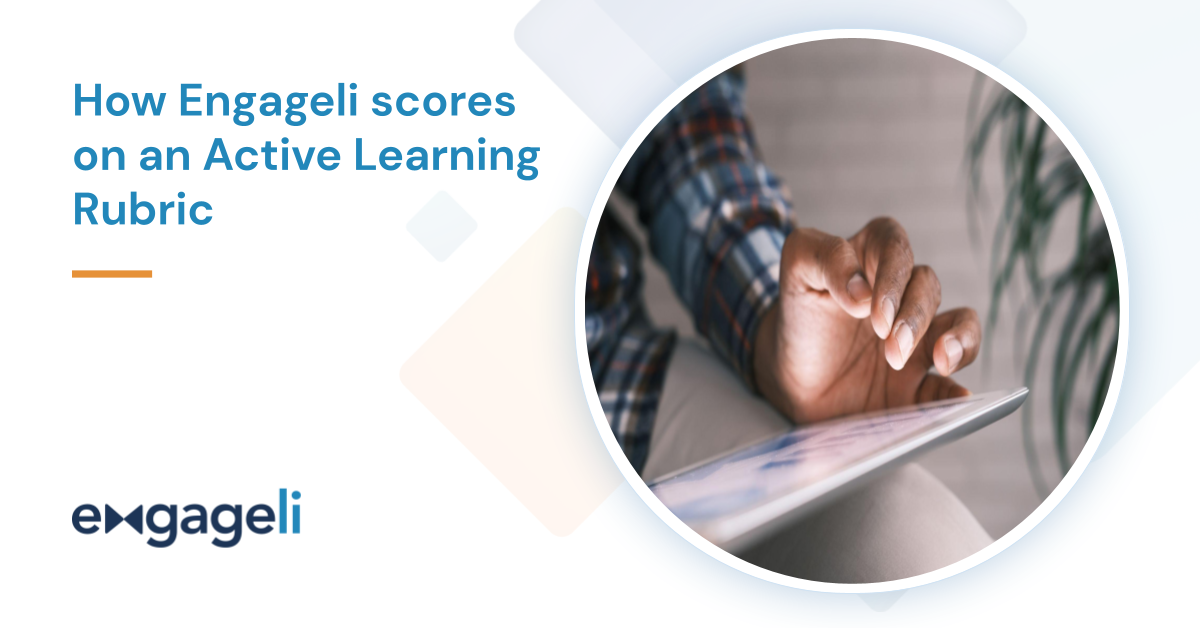The post referenced above refers to an Educause article about selecting active learning technologies and points to a rubric to evaluate digital tools. The goal of this series is to evaluate Engageli against this rubric and get you to more deeply understand why video conferencing software is no substitute for a purpose-built comprehensive learning platform such as Engageli. Since Engageli was created in order to support active learning, it should come as no surprise that it performs well—dare I say amazingly well?—in this rubric. I will describe in relative detail how Engageli meets the demands described in the six categories within this rubric so that you can judge for yourself:
- Easy to use
- Participation
- Broadly available
- Equitable
- Flexible
- Suitable for active learning activities
Each article in the series will address one of the criteria from the rubric, but before I dive into the details of the platform here is a snapshot of how Engageli meets the basic criteria of the rubric.
Easy to use
In order to be easy to use, the technology has to be easy to access. Unlike other videoconferencing tools, Engageli is a Web app that works on either Chrome or Edge browsers—no app download is necessary to use Engageli on a desktop or laptop computer. Further, a free iOS app is available for learners who want to work from their Apple tablet or phone. (And, soon, an app will also be available for Android devices.) Engageli presents a familiar interface to learners and instructors with differences that are easily navigable—it looks like a videoconferencing application, but it provides so much more functionality. Engageli’s new version 3.0 has been even further enhanced for ease of use (learn more about it here).Participation
The core of an Engageli classroom is the table architecture, where learners are split into groups so that they can work on a task together. They can speak without worrying about interrupting other tables, but still raise their hands in order to address the instructor or class. The instructor can still see all of the learners and address them as a group while they are at their tables. This differentiates a learner’s ability to participate significantly from breakout rooms in typical videoconferencing platforms. Engageli’s built-in polls, reactions, and enhanced chat (read more about chat in v3.0) allow for multiple modes of participation. Engageli’s asynchronous experience is unique so learners who miss a class can listen to the lecture, watch videos, respond to polls, or work on problem sets with up to 10 peers! They can talk or chat amongst themselves—just as if they were in the original live session. Attending an asynchronous class doesn’t have to be a solo activity with Engageli.Broadly available
This category is about how easily and broadly available the technology is. Engageli is free for learners, requires no download, runs on a wide variety of hardware, and can be integrated easily into an institution’s Learning Management System or Single Sign On.Equitable
Engageli is committed to creating an equitable learning experience for all learners—Engageli is WCAG AA 2.0 compliant, and has all standard accessibility features including closed captioning, compatibility with screen readers and keyboard navigation, adjustment for color-blindness, and more. A new feature in v3.0 is the ability for a learner to overlay a sign language interpreter over their Engageli classroom. Engageli’s multiple modes of participation also plays a role in inclusive teaching and learning in an Engageli classroom. Engageli’s data dashboard empowers instructors to gain insights into how learners are participating in the classroom and table activities beyond what is possible in an in-person classroom. This allows instructors to identify learners who might be falling behind or otherwise are disengaged from the class.Flexible
Engageli is extremely flexible, allowing instructors to use a wide variety of pedagogies, some of which would be difficult to use in a face-to-face setting. Instructors can seamlessly transition between full class and table activities without any delay (such as what you might find in breakout rooms), and split learners by their poll responses instantaneously (which would require significantly more time in-person). The possibilities with an Engageli classroom are endless.Suitable for active learning activities
Engageli was designed intentionally for active and collaborative learning. The rubric looks at the ability for an instructor to monitor learner progress easily and check for understanding, which Engageli enables in many ways—from the tables to live-time engagement markers, and post-session data analytics. Engageli allows instructors to easily focus learners' attention by setting up timer, and polls, and nudging individuals to raise their hand or contribute to the class.This just scratched the surface of the ways in which Engageli demonstrates its ability to enable active learning—if you are interested in how Engageli can be used in your classroom, please email partnerships@engageli.com to get a live demo.
And if you want to explore any of these criteria in depth, follow along in this series as I dive into each one separately.

